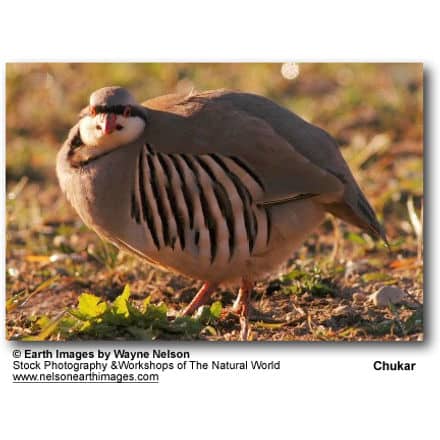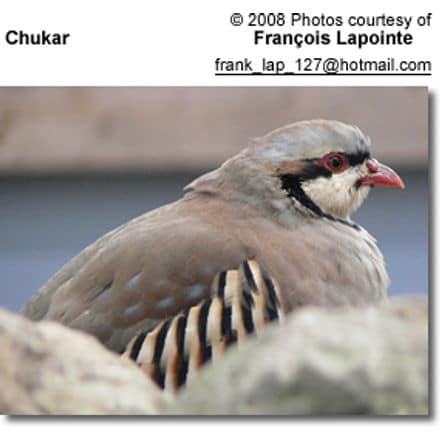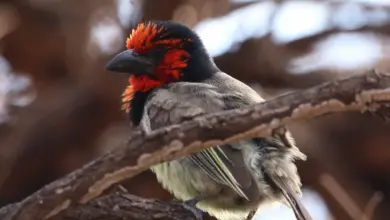Chukar Partridges
The Chukars Partridges (Alectoris chukar) – also known as Chukar (sometimes spelled: Chukker, Chuker or Chukor), Indian Chukar, Keklik, or Chakhoor in the national language of Pakistan “Urdu”.
This species’ common name was derived from its noisy song, which ends in chuKAR chuKAR.
The Chukars are native of the Middle East and southern Asia, but have been widely introduced throughout much of the western United States and southern Canada.
Chukars have distinctive black and white bars on the flanks and a black band running from the forehead across the eyes and running down the head forming a necklace that enclose the white throat and cheeks.
Distribution / Range:
The Chukars occurs naturally in Asia – from Pakistan and Afghanistan in the east to southeastern Europe in the west.
They are native to the following countries:
Afghanistan, Armenia, Azerbaijan, Bulgaria, China, Cyprus, Egypt, Georgia, Greece, India, Iran, Iraq, Israel, Jordan, Kazakhstan, Kyrgyzstan, Lebanon, Mongolia, Nepal, Oman, Pakistan, Palestine, Russia, Saudi Arabia, Syria, Tajikistan, Turkey, Turkmenistan, Ukraine, United Arab Emirates and Uzbekistan.
They have been introduced (mainly as game birds) to many parts of the word; and feral populations have established themselves outside their native range in the following countries:
North America (United States, Hawaii, Canada); Europe (France, Germany, Great Britain, Italy, Macedonia (formerly Republic of Yugoslav), Norway, Portugal and Spain); Africa (South Africa, Saint Helena, Robben Island); New Zealand;
Formerly: Australia (New South Wales) – but likely extinct in that area.
USA / Canada:
Feral populations have established themselves from south-central British Columbia in western Canada, south through eastern Washington State, southeastern Oregon, southwestern Idaho, and central and eastern Montana south through Colorado, western Utah and southern Nevada, northeastern and high desert areas of southern California, south to Baja California Norte; and west to Hawaii.
Small populations have been reported in southern Alberta and as far north as Northern British Columbia, Smithers (Canada); as well as western South Dakota, Arizona and New Mexico in the USA.
Those birds that were initially introduced into North America were from the nominate race (Alectoris chukar chukar) that were taken from Afghanistan and Nepal. However, over time, other subspecies have likely intermixed.

Habitat / Movements:
Chukars are mostly sedentary (permanent residents); however, seasonal altitudinal movements may occur, as they move from higher elevations to lower terrain during heavy snows; or they may move onto south-facing slopes to escape inclement weather.
They typically prefer dry, rocky, open hillsides and canyon sides with sufficient vegetative cover, such as grass, scattered scrub, sagebrush, bushes, etc. They typically avoid areas with a high humidity or frequent rainfalls.
Subspecies and Ranges
- Alectoris chukar chukar (JE Gray, 1830) – nominate form
- Range: Eastern Afghanistan south and east through India to Nepal
- Island Chukar (Alectoris chukar cypriotes – Hartert, 1917)
- Range: Southeastern Bulgaria east through Asia Minor to southern Syria, southern Aegean Island, Crete, Rhodes and Cyprus.
- Alectoris chukar dzungarica (Sushkin, 1927)
- Range: Northwestern Mongolia to Russian Altai Mountains and eastern Tibet
- Alectoris chukar falki (Hartert, 1917)
- Range: North central Afghanistan to Pamir Mountains (on the border of Afghanistan and Tajikistan) and western China
- Alectoris chukar kleini (Hartert, 1925)
- Range: Northern Greece though Bulgaria and northern Turkey to the Caucasus
- Persian Chukar (Alectoris chukar koroviakovi – Zarudny, 1914)
- Range: Eastern Iran to Pakistan
- Iranian Chukar (Alectoris chukar subpallida – Zarudny, 1914)
- Range: Tajikistan (Kyzyl Kum and Kara Kum mountains)
- Alectoris chukar werae (Zarudny and Loudon, 1904)
- Range: Eastern Iraq and southwestern Iran
- Kurdestan Chukar (Alectoris chukar kurdestanica – Meinertzhagen, 1923)
- Range: Caucasus Mountains south to Iran
- Northern Chukar –Alectoris chukar pallescens (Hume, 1873)
- Range: Northeastern Afghanistan to Ladakh (northern India) and western Tibet
- Alectoris chukar pallida (Hume, 1873)
- Range: Nnorthwestern China in western and southern Xinjiang
- Alectoris chukar potanini (Sushkin, 1927)
- Range: Western Mongolia
- Alectoris chukar fallax (Sushkin, 1927)
- Range: Northwestern China, in the Tien Shan Mountains of northwestern Xinjiang.
- Alectoris chukar pubescens (Swinhoe, 1871)
- Range: China, from western Qinghai and western Sichuan northeast through Inner Mongolia to Liaoning.
- Alectoris chukar sinaica (Bonaparte, 1858)
- Range: Northern Syrian Desert S to Sinai Peninsula.
Description:
The Chukar is a medium-sized, short-necked, chicken-like partridge that measures about 13 – 14 inches (32 – 35 cm) in length, including its short tail. The average weight range is 17.97 – 23.96 oz (510 – 680 g), with males being slightly larger than females (males weighing between 510 – 800g; females from 450 – 680g).
The back is light brown back. The chest is grey and the abdomen is buff-colored, with rufous-streaked flanks. Geographical plumage differences have been noted with those occurring in more arid areas tending to be greyer and paler.
The face and throat are white framed by a distinctive black line.
The legs are red. They are not the best fliers and prefer running to flying; however, they can fly short distances, if necessary.
Males and females look alike; except the males are slightly larger in size.
Juveniles look like adults, except they are generally smaller and their plumage is mostly brownish grey with faint brown barring.
Similar Species:
It resembles the Rock Partridge, Alectoris graeca, but is browner on the back and has a yellowish tinge to the foreneck.
It can be differentiated from the Red-legged Partridge by its sharply defined throat patch (gorget).
The Barbary partridge has a reddish brown collar (rather than black collar) with a grey throat and face, and a chestnut crown.
Breeding / Nesting:
Chukars are monogamous (with close pair bonds). In North America, they mostly breed from April to June (during the summer). Males actively defend their nesting territories and their females from other males.
Pairs form in February through mid-March. The males perform courtship displays that involve tilting their heads and showing off their barred flanks. The willing female usually participates in a “tidbitting display” pecking at various objects.
This is a resident breeder in dry, open, and often hilly country. It nests in a scantily lined ground scrape, lined with leaves and feathers. The average clutch consists of 8 up to 20 eggs. They usually produce one clutch a season; however, in activity, double-clutching (two consecutive clutches) are reported, and may also occur in wild populations. The eggs are incubated for about 23 – 25 days. The hatchlings are able to leave the nest shortly after hatching. Fledging (first flights) occur as early as two weeks after hatching. They reach adult size in about 12 weeks.
Diet / Feeding
Chukars will feed on a wide variety of seeds, leaves, grasses, berries, shrub fruits, and some insects (such as grasshoppers, caterpillars, crickets, ants, and various insect eggs) as food; however, they have shown a strong affinity for Drooping Brome (Cheatgrass). These opportunistic feeders will also take cultivated grains. They usually satisfy their water needs by eating succulent vegetation (water-retaining plants); but may visit open water in the summer.
They usually forage on the ground, but may move up into the trees and shrubs for berries and insects.
Chicks mostly feed on insects, to fill their requirement for protein needed for growth.
Chukars usually feed in throughout the morning and afternoon.
Calls / Vocalizations
Their most common calls are described as a series of noisy, whiny chuck, chuck, chuck, gradually ending in chuKAR chuKAR (hence their common name).
Their calls are frequently heard during the day, especially in the mornings and evenings.
Partridge Info & Species … Partridge Photo Gallery


